|
Pseudoscorpions
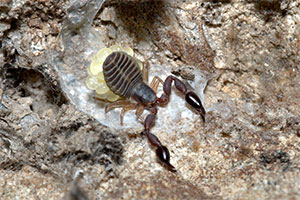
False scorpion from forest litter, Canterbury region, South Island, New Zealand. Common name: pseudoscorpions, false scorpions.
Scientific name: phylum Arthropoda, class Arachnida, order Pseudoscorpionida — “false scorpions”.
Description
The false scorpions are small (usually less than 5 mm), brownish arachnids with large pincer-like pedipalps and flattened body. As their name suggests, they resemble miniature scorpions without the long stinging tail. The body of a pseudoscorpion has two distinct regions - the anterior cephalothorax and the posterior abdomen. The cephalothorax is covered dorsally by a sclerotized shield (carapace) and bears all the appendages.
The main organs of sense are the long sensory (tactile) setae on the body and appendages, other senses are poorly developed. Eyes are sometimes present as 1-2 pairs of simple ocelli on the carapace, but many pseudoscorpions lack eyes.
The short chelicerae (first pair of appendages) sit closely together at the front of the cephalothorax; they are used for feeding. Chelicerae also bear the openings of silk glands. The large conspicuous pedipalps with terminal pincers are the second pair of appendages. The pedipalps are used for prey capture and defence, and the venom glands (if present) open at the tips of the pincers. Like all other arachnids (spiders, scorpions, mites and ticks), false scorpions have eight walking legs.
The segmented abdomen is oval or elongated in shape, rounded, and broadly connected to the cephalothorax. Each of the abdominal segments is covered dorsally by a sclerotized plate. The abdomen has no appendages.
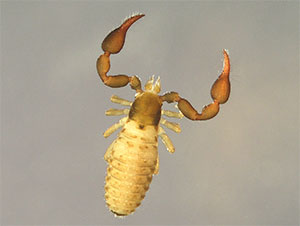
False scorpion, dorsal view. |
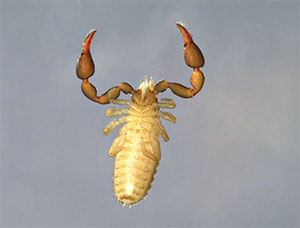
Same false scorpion, ventral view. |
Notes on biology
Similar to other arachnids (spiders, scorpions, etc.), pseudoscorpions are predators. Their diet is poorly known, but observations suggest they may prey on a variety of small soil arthropods. The prey is grasped with the pincers of the large pedipalps, subdued with venom, and then macerated with chelicerae and sucked dry. The coxae of the pedipalps aid in food processing.
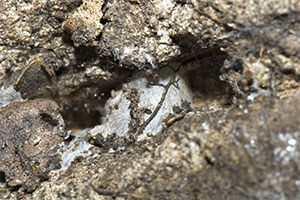
Silk chamber of a pseudoscorpion, Canterbury, South Island of New Zealand. |
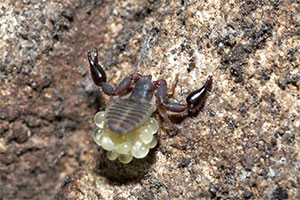
Female pseudoscorpion carrying her eggs, Canterbury, South Island of New Zealand. |
During mating, adult male and female pseudoscorpions have been observed to perform elaborate courtship rituals and mating dances. The fertilization itself is external. The male leaves the packet of sperm (spermatophore) on the substrate, from where the female picks it up to fertilize her eggs. The fertilized eggs are kept in a brood pouch attached to the abdomen of the female, remaining there until the young pseudoscorpions emerge. The newly hatched pseudoscorpions resemble adults, and moult two more times before reaching maturity. In some species males are rare and females are thought to reproduce parthenogenetically. Using their silk glands, pseudoscorpions construct protective silk chambers for brooding, overwintering, and moulting. These chambers can be someimes observed on the underside of rocks. The pseudoscorpion chamber is dirty-grey on the outside due to incorporated debris; the interior of the chamber is lined with clean white silk. Adult pseudoscorpions may live for several years. Pseudoscorpions are completely harmless to humans.
Where to find them?
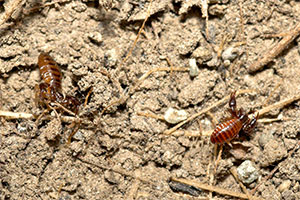
Two false scorpions, South Island, New Zealand.
Pseudocorpions are small and cryptic animals. They are widespread in all types of forests, tussock grasslands, agricultural and urban environments, but are never very abundant. In New Zealand pseudoscorpions live under rocks on the ground, in leaf litter, in soil, garden compost, dung, and in all sorts of organic detritus. Often they occur on standing trees beneath bark, in moss and lichens, and in the detritus at the bases of epiphyte plants. Many are found in the nests of bees and ants, in the nesting burrows of birds, ground-dwelling mammals, in chicken coops, etc. Some species live in caves. False scorpions can be encountered in quite dry situations, as well as in damp environments.
Surprisingly, pseudoscorpions can be found in the traps set to catch flying insects. These are dispersing pseudoscorpions, which attach themselves to a flying insect (often it is a fly), and are carried from place to place. Occasionally false scorpions may disperse on birds and mammals. This phoretic (dispersal) behaviour does not harm their carriers. A cosmopolitan species Chelifer cancroides (the tiny dark-brown "book scorpion") is found in houses.
Pseudoscorpions can be picked from their habitat directly, or more easily, collected with the substrate and separated from litter and debris in a Berlese funnel. Often pseudoscorpions are found in pitfall traps. Phoretic pseudoscorpions can be discovered in the traps used to collect their flying hosts. Pseudoscorpions can be preserved and stored in 75% alcohol.
Distribution and conservation
About 2000 species of pseudoscorpions are known to science. They are found everywhere but the Polar regions, although the fauna of the temperate zone is less rich. The greatest diversity of pseudoscorpions is found in the tropics. In Australia there are 150 species from 18 families and 56 genera. In New Zealand, the fauna is less diverse, with 70 species known in 28 genera, 25 genera are native to New Zealand. The endemism of genera and species is very high - 13 of the native genera are endemic to New Zealand. Other New Zealand genera have representatives in Australasia and the Pacific, South America, and South Africa.
Three introduced species are found in New Zealand, which most likely have been brought in by human trade. One of the introduced species is the cosmopolitan Chelifer cancroides, or the book scorpion - a synanthropic species common in domestic situations.
Included images:
- Order Pseudoscorionida
- Unidentified species - Parsons Creek, Lake Ohau, MK, South Island (3 images)
- Unidentified species - Temple Valley, Lake Ohau, MK, South Island
- Unidentified species - Lake Alexandrina, MK, South Island (3 images)
- Unidentified species - Wanganui, WI, North Island (4 images)
Further information on New Zealand Pseudoscorpions:
Beier M., 1976. The pseudoscorpions of New Zealand, Norfolk, and Lord Howe. New Zealand Journal of Zoology 3, p. 199-246.
Forster RR. 1974. False scorpions. New Zealand 's Nature Heritage 3 (32), p. 883-884.
Muchmore, W. B. 1990. Pseudoscorpionida. In: Dindal D.L. (ed.). Soil Biology Guide. J. Wiley & Sons, New York, p. 503-527.
Pseudoscorpionida Resources on the Web
Pseudoscorpions, by William F. Lyon, Ohio State University Extension Fact Sheet - description of ecology, with drawings of 3 species.
Pseudoscorpions, R.L. Smith. The University of Arizona, Urban Integrated Pest Management; description of biology and drawing.
Pseudoscorpions, by Gerald Legg; notes on the British species with distribution maps, research information, publications, and images of species.
Pseudoscorpions, The Arabian Wildlife Magazine Online; general information on pseudoscorpions of the United Arab Emirates.
Pseudoscorpiones - False scorpions, Staffordshire Biodiversity Action Plan; the list of known false scorpions present in Staffordshire, UK.
Pseudoscorpiones - False scorpions, CSIRO, short information on life cycle, feeding, habitat, some pictures.
Pseudoscorpions, Entomology notes, The Michigan Entomological Society (USA); good source of information on distribution, collecting, and preservation of pseudoscorpions.
Australian Faunal Directory: References for PSEUDOSCORPIONES, references to the world fauna.
Australian Faunal Directory: Checklist for Pseudoscorpiones, description, diagnosis and check-list of Australian Fauna, refetences for Australia.
|